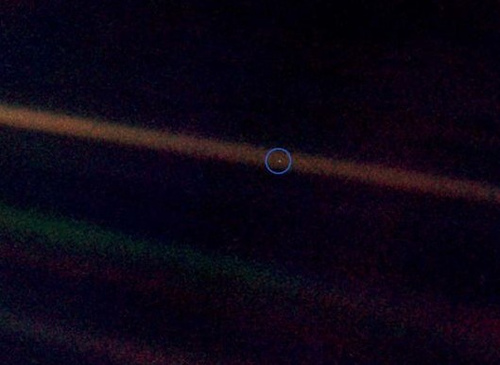The Voyager program is a U.S program that launched two unmanned space missions, scientific probes Voyager 1 and Voyager 2. They were launched in 1977 to take advantage of a favorable planetary alignment of the late 1970s. Although officially designated to study just Jupiter and Saturn, the probes were able to continue their mission into the outer solar system, and are as of December 2011 on course to exit the solar system. These probes were built at JPL and were funded by NASA. Voyager 1 is currently the farthest human-made object from Earth. Both missions have gathered large amounts of data about the gas giants of the solar system, of which little was previously known. In addition, the spacecraft trajectories have been used to place limits on the existence of a hypothetical trans-Neptunian planet.
Voyager 1 and 2 both carry with them a golden record that contains pictures and sounds of Earth, along with symbolic directions for playing the record and data detailing the location of Earth. The record is intended as a combination time capsule and interstellar message to any civilization, alien or far-future human, that recovers either of the Voyager craft. The contents of this record were selected by a committee chaired by Carl Sagan.
en.wikipedia.org...
The Voyager 1 spacecraft is a 722 kilogram (1,592 lb) space probe launched by NASA in 1977, to study the outer Solar System and interstellar space. Operating for 34 years, 4 months and 24 days as of today (current operation time), the spacecraft receives routine commands and transmits data back to the Deep Space Network. At a distance of 119 astronomical units (1.78×1010 km) as of October 2011, it is the farthest man-made object from Earth. Voyager 1 is now in the heliosheath, which is the outermost layer of the heliosphere. It will most likely be the first probe to leave the Solar System. Being a part of the Voyager program with its sister craft Voyager 2, the spacecraft is in extended mission, tasked with locating and studying the boundaries of the Solar System, including the Kuiper belt, the heliosphere and interstellar space. The primary mission ended November 20, 1980, after encountering the Jovian system in 1979 and the Saturnian system in 1980. It was the first probe to provide detailed images of the two largest planets and their moons.
Now for the interesting part, apparently aliens have found one of the spacecraft's and used the disc to create their own remix of it, which they then transmitted back to SETI. What these remixes could mean if you listen to the music who knows. It sounds like crazy alien tech house! Anyway these remixes have been called "The scrambles of Earth," since the original record was called "Murmurs of Earth" and they 'scrambled' or remixed our version. You can buy the CD online but why would you do that when you can listen for free....
boomkat.com...
What follows is some of the explanatory text accompanying this curious release on Negativland's Seeland label - this is just a fragment, mind you, there's an illustrated 16-page booklet inside the CD digpak. Here goes: "In 1977, NASA launched the twin Voyager 1 and 2 spacecrafts, fastening to each a phonograph album containing sounds and music of Earth." So far so good; go on... "In 2010, the Search for Extraterrestrial Intelligence in Exile (SETI-X), a dissident offshoot of the better-known Search for Extraterrestrial Intelligence, received transmissions believed to be extraterrestrial remixes of these records." Ah. Yes, this album purports to contain evidence of a first contact with alien lifeforms, whose primary means of communication appears to be the remix. So what does ET sound like? Well, by some uncanny coincidence these alien intelligences seem to operate in a fashion that perfectly conforms to the well-worn Negativland A&R policy, serving up skewed and skewered alterations and edits of sampled source material that switch between noisy, abstract weirdness and loungey exotica. Interesting stuff though, and certainly a release to be savoured by fans of plunderphonics and old-school V\VM releases.
Scrambles Of Earth: The Voyager Interstellar Record, Remixed By Extraterrestrials by SETI-X - MP3 Release - Boomkat - Your independent music specialist

 you gotta start somewhere
you gotta start somewhere

